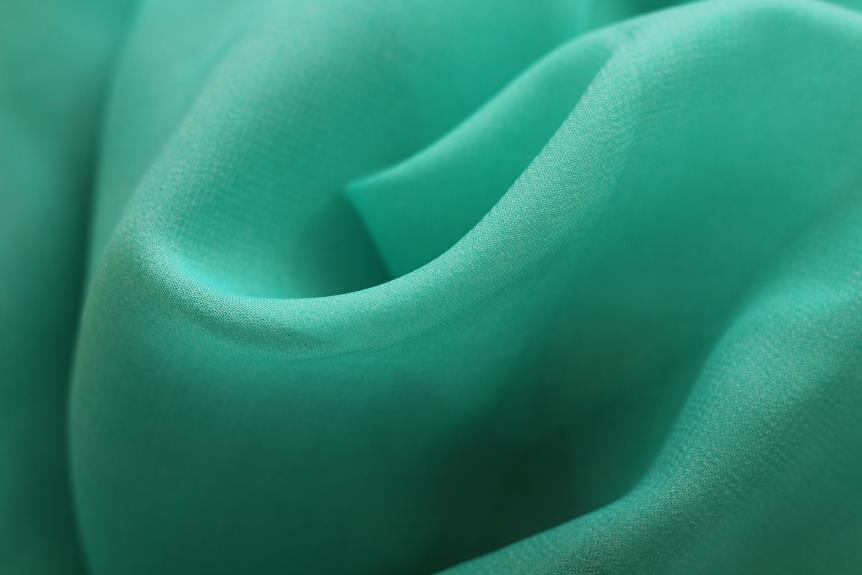So, you're looking to dive into the world of performance fabrics, and you've come to the crossroads of Lycra and polyester. Both have their merits, but which one reigns supreme?
Let's unravel the intricacies of these fabrics to determine which one suits your needs best. From fabric composition to moisture-wicking properties, durability to comfort, each has its own strengths and weaknesses.
By delving into the nitty-gritty details, you'll gain a deeper understanding of how these fabrics stack up against each other. So, without further ado, let's embark on this journey of fabric exploration and unravel the mystery of which fabric – Lycra or polyester – holds the crown.
Key Takeaways
- Lycra is known for exceptional elasticity and is commonly blended with other materials like cotton, polyester, or nylon.
- Polyester is a durable, synthetic fiber known for quick-drying and moisture-wicking properties and is often blended with other fibers to improve breathability and comfort.
- Lycra outperforms polyester in terms of stretch and recovery, but the choice between the two depends on garment requirements and intended use.
- Both Lycra and polyester excel in pulling moisture away from the skin and have quick-drying capabilities, making them suitable choices for intense workouts or outdoor activities.
Fabric Composition
When choosing between Lycra and polyester, consider the fabric composition that best suits your needs and preferences. Fabric composition plays a crucial role in determining the performance and comfort of clothing.
Lycra, also known as spandex or elastane, is a synthetic fiber known for its exceptional elasticity. It's commonly blended with other materials like cotton, polyester, or nylon to enhance stretch and shape retention.
On the other hand, polyester is a durable, synthetic fiber known for its quick-drying and moisture-wicking properties. Polyester fabrics are often blended with other fibers to improve their breathability and comfort.
Understanding the material characteristics of each fabric is essential in making an informed decision. Lycra offers superior stretch and recovery, making it ideal for form-fitting garments and sportswear. Polyester, with its moisture-wicking and quick-drying abilities, is well-suited for activewear and outdoor apparel.
Both fabrics have their unique benefits, and selecting the right fabric composition depends on the specific requirements of your intended use.
Stretch and Flexibility
To achieve the right balance between stretch and flexibility in your clothing, you need to understand how Lycra and polyester differ in their performance and comfort.
When it comes to flexibility comparison, Lycra stands out for its exceptional elasticity, allowing the fabric to stretch significantly and then return to its original shape. This feature makes Lycra a popular choice for activewear and form-fitting garments, providing a snug yet flexible fit for various body shapes and movements.
On the other hand, polyester, while not as elastic as Lycra, offers good flexibility and shape retention, making it suitable for a wide range of clothing, from sportswear to everyday apparel.
When evaluating the elasticity assessment, Lycra tends to outperform polyester in terms of stretch and recovery, making it a preferred option for activities that require extensive movement and flexibility.
However, both fabrics have their own strengths, and the choice between Lycra and polyester ultimately depends on the specific requirements of the garment and the intended use.
Moisture-wicking Properties
In considering moisture-wicking properties, both Lycra and polyester offer distinct advantages for managing sweat and maintaining comfort during physical activity. When it comes to sweat absorption, both fabrics excel in pulling moisture away from the skin, keeping you dry and comfortable. Lycra and polyester are equally effective in this aspect, making them suitable choices for intense workouts or outdoor activities.
Additionally, they both demonstrate quick drying capabilities, ensuring that any moisture is rapidly evaporated, preventing the discomfort of dampness during your workout. This quick drying feature allows you to stay focused on your exercise without being distracted by sweat-soaked clothing.
Moreover, both fabrics are adept at regulating body temperature by allowing sweat to evaporate, preventing overheating during vigorous physical activities. Whether you prefer Lycra or polyester, you can rely on their exceptional moisture-wicking properties to keep you dry and comfortable throughout your workout.
Durability and Longevity
When it comes to durability and longevity, both Lycra and polyester have their own strengths and weaknesses.
Lycra is known for its stretch resilience, which allows it to maintain its shape and elasticity over time.
On the other hand, polyester is valued for its strength and endurance, making it less prone to wear and tear.
Understanding the comparative wear and tear of these fabrics can help you make an informed decision about which one suits your needs best.
Lycra Stretch Resilience
Lycra's stretch resilience ensures its durability and longevity, making it a reliable choice for various active wear and athletic garments. This unique characteristic allows Lycra to maintain its shape and elasticity even after multiple wears and washes. Here's why Lycra's stretch resilience sets it apart:
- Retains shape and elasticity over time
- Provides freedom of movement without compromising durability
- Offers exceptional recovery after stretching
- Withstands frequent washing without losing its stretch
This means that garments made with Lycra are well-suited for intense physical activities, as they can endure the demands of active lifestyles while retaining their flexibility and shape.
In comparison, while polyester may excel in moisture-wicking properties, Lycra's stretch resilience makes it an ideal choice for enduring and flexible athletic wear.
Polyester Strength and Endurance
Polyester's strength and endurance contribute to its reputation for durability and longevity, making it a dependable choice for a wide range of garments, particularly those designed for rigorous use.
Polyester is known for its exceptional durability, with the ability to withstand repeated wear and washing without losing its shape or color. This fabric's resilience makes it ideal for sportswear, outdoor gear, and work uniforms, where longevity is essential.
Unlike Lycra, which is prized for its elasticity, polyester excels in retaining its strength and form over time. Its resistance to stretching, shrinking, and wrinkling ensures that garments made from this fabric maintain their shape and appearance even after prolonged use.
The enduring nature of polyester makes it a reliable option for those seeking long-lasting, hard-wearing clothing.
Comparative Wear and Tear
To assess the comparative wear and tear of Lycra and polyester, consider their durability and longevity as key factors in determining the better fabric for your specific needs.
When evaluating fabric maintenance and material lifespan, it's important to delve into the following aspects:
- Fabric Maintenance: Lycra requires delicate care to maintain its elasticity, whereas polyester is relatively low-maintenance, making it easier to care for in the long run.
- Material Lifespan: Lycra is highly elastic and may lose its shape over time with frequent use and washing. On the other hand, polyester is known for its resilience and ability to retain its shape and color, thus offering a longer lifespan.
Understanding these factors will help you make an informed decision based on your individual preferences and requirements.
Comfort and Breathability
When considering comfort and breathability, the choice between Lycra and polyester comes down to your personal preferences and specific needs.
Lycra, known for its stretch and comfortable fit, provides a snug, supportive feel, making it an excellent choice for activewear and form-fitting garments. Its elasticity allows for freedom of movement, contributing to a comfortable fit during various activities.
On the other hand, polyester, with its breathable design, wicks moisture away from the skin, making it suitable for intense workouts or hot weather. The moisture-wicking properties of polyester help in keeping you dry and comfortable during physical activities, making it a popular choice for sportswear and outdoor clothing. However, some individuals may find polyester to be less comfortable in terms of its feel against the skin compared to Lycra.
Ultimately, whether you prioritize a comfortable fit or a breathable design will depend on your specific requirements and the intended use of the fabric. Both Lycra and polyester offer unique benefits, so it's important to consider your individual needs when making a choice.
Versatility and Applications
When it comes to versatility and applications, both Lycra and Polyester have their own strengths.
Lycra is known for its exceptional stretch and recovery, making it a popular choice for athletic wear performance.
On the other hand, Polyester is often favored for its durability and resistance to wrinkles, making it a common choice for fashion and activewear.
These unique qualities make each fabric suitable for a variety of uses, catering to different needs and preferences.
Athletic Wear Performance
For athletic wear performance, both Lycra and polyester offer versatility and applications that cater to various exercise activities. When considering the performance benefits and material suitability, these fabrics excel in different ways:
- Lycra:
- Offers excellent stretch and recovery, making it ideal for form-fitting and compression garments.
- Enhances freedom of movement, crucial for activities like yoga, Pilates, and dance.
- Provides muscle support and reduces muscle fatigue during intense workouts.
- Wicks moisture away from the body, keeping you dry and comfortable during high-intensity workouts.
- Polyester:
- Known for its durability and quick-drying properties, making it suitable for high-impact activities like running, cycling, and team sports.
- Resists shrinking and wrinkling, maintaining its shape and appearance even after repeated washes.
- Offers excellent breathability, allowing heat and sweat to escape, which is beneficial for endurance activities.
- Provides UV protection, making it suitable for outdoor exercises.
Fashion and Activewear
You frequently choose activewear based on its versatility and applications, so let's compare how Lycra and polyester perform in the realm of fashion and activewear.
In terms of fashion trends, Lycra offers a sleek and form-fitting look, making it ideal for trendy activewear designs. Its ability to stretch and retain its shape also contributes to its popularity in fashion-forward activewear.
On the other hand, polyester is known for its durability and wrinkle resistance, making it suitable for activewear that requires frequent washing and intensive use.
When it comes to sustainable materials, Lycra is often blended with other fabrics, which can impact its sustainability. Meanwhile, some polyester fabrics are made from recycled materials, contributing to a more sustainable approach.
Consider the specific fashion trends and sustainability goals when choosing between Lycra and polyester for your activewear needs.
Environmental Impact
Considering the environmental impact, it's important to understand how both Lycra and polyester fabrics affect the planet.
- Environmental Impact: Both Lycra and polyester have a significant environmental impact due to the production process and the resources used. Lycra is made from synthetic fibers derived from petroleum, while polyester is also a petroleum-based synthetic fiber. The extraction and processing of petroleum have a notable environmental impact, contributing to pollution and greenhouse gas emissions.
- Global Supply Chain: The global supply chain of both fabrics adds to their environmental impact. Lycra and polyester are often manufactured in countries with less stringent environmental regulations, leading to pollution of waterways and air.
- Sustainability Initiatives: Some companies are making efforts to reduce the environmental impact of Lycra and polyester. These initiatives include using recycled materials, reducing water and energy consumption in production, and implementing more sustainable manufacturing practices.
- Carbon Footprint: Both fabrics have a substantial carbon footprint, with polyester being particularly energy-intensive to produce. Efforts are being made to decrease this footprint through improved manufacturing processes and the use of eco-friendly materials.
Cost and Affordability
How much more cost-effective is Lycra compared to polyester for your athletic wear needs?
When it comes to the cost comparison between Lycra and polyester, Lycra tends to be slightly more expensive than polyester. However, the price difference is often minimal, especially when considering the overall quality and performance benefits that Lycra offers.
While polyester is known for being one of the most budget-friendly options in the athletic wear market, Lycra provides a superior level of elasticity and shape retention, making it a valuable investment for individuals seeking high-performance activewear.
When evaluating cost and affordability, it's essential to consider the longevity and durability of the fabric. Lycra's ability to maintain its shape and elasticity over time can result in a longer lifespan for garments, potentially offsetting the initial higher cost.
Additionally, the enhanced comfort and flexibility provided by Lycra may justify the slightly higher price point for many consumers who prioritize performance and quality in their athletic wear.
Ultimately, both Lycra and polyester offer budget-friendly options, but the decision between the two fabrics may depend on individual preferences and priorities.
Frequently Asked Questions
Can Lycra or Polyester Fabrics Cause Skin Irritation or Allergies?
For those with skin sensitivity, both lycra and polyester fabrics can potentially cause fabric allergies. It's important to consider your individual skin type and any known allergies when choosing between these materials for clothing.
What Are the Best Care Instructions for Lycra and Polyester Fabrics to Maintain Their Quality?
To maintain Lycra's elasticity, wash in cold water and air dry. Polyester, being breathable, benefits from machine washes. Both fabrics last longer with gentle detergents. Prioritize air drying to preserve durability and breathability.
Are There Any Specific Sports or Activities Where Lycra Is Preferred Over Polyester, or Vice Versa?
For swimming, Lycra offers flexibility and comfort, while polyester provides durability and color retention. In yoga, Lycra's stretch is ideal for dynamic movements, whereas polyester's moisture-wicking properties can be beneficial. Each fabric has its advantages.
How Do Lycra and Polyester Fabrics Compare in Terms of Their Environmental Sustainability and Impact?
When comparing lycra and polyester fabrics, consider their environmental impact, manufacturing processes, and sustainability. Assess skin sensitivity, care instructions, activity preference, and potential health risks from extended wear to make an informed choice.
Are There Any Potential Health Risks Associated With Wearing Lycra or Polyester Fabrics for Extended Periods of Time?
Wearing lycra or polyester fabrics for extended periods may pose potential health risks, like skin irritation and restricted breathability. Comfort level varies, but proper care and breaks can mitigate these issues.
- A Technical Guide to Meltblown Nonwoven Manufacturing - July 11, 2025
- The Pros and Cons of Nonwoven Fabrics: A Balanced View - July 11, 2025
- Nonwoven Fabric 101: Everything a Beginner Needs to Know - July 11, 2025







